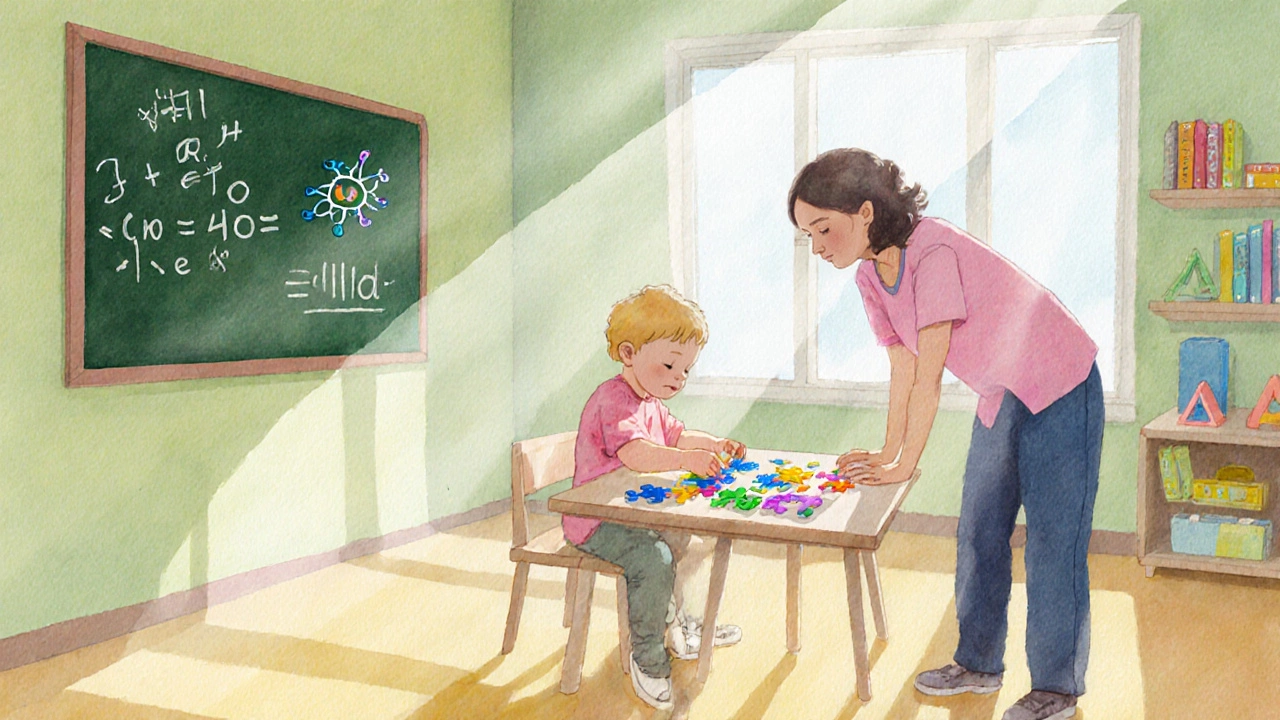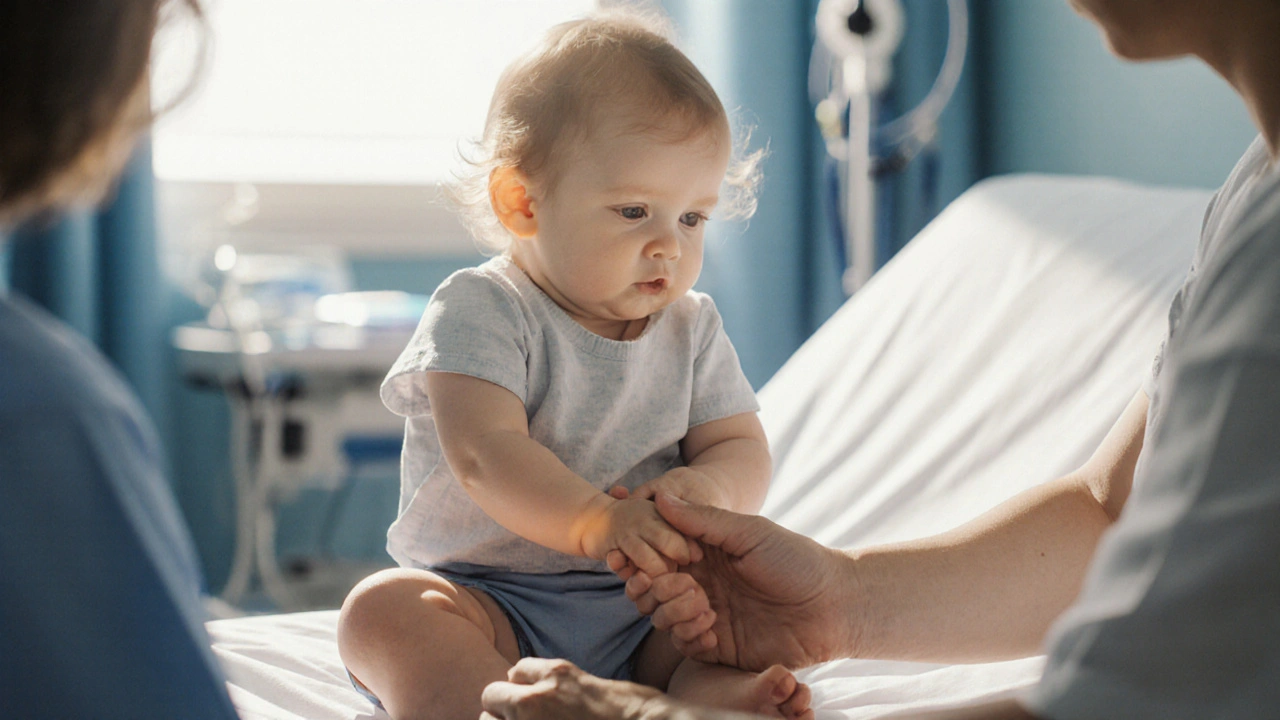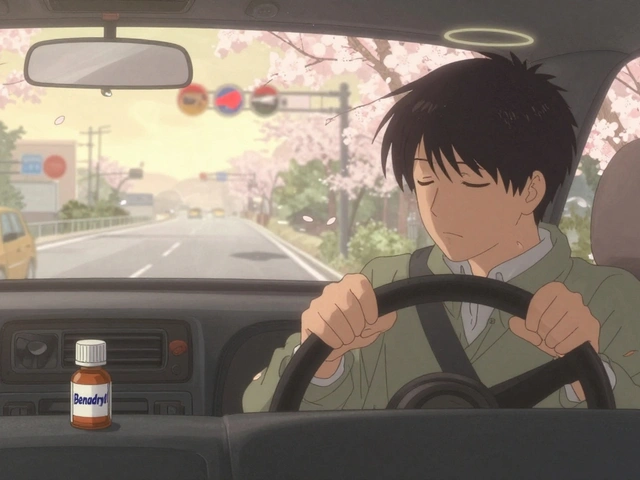Neuroblastoma Development Impact Calculator
This calculator estimates potential impacts on child development based on treatment type and tumor characteristics. Results are educational and should not replace professional medical advice.
Results are based on research findings from pediatric oncology studies regarding neuroblastoma treatment effects.
Enter treatment information and click "Analyze Developmental Impact" to view results.
Physical Growth
Impact varies by treatment type and tumor location. Radiation near growth plates may cause stunted height.
Cognitive Function
Chemotherapy and radiation may affect memory, attention, and processing speed. Early neuropsychological assessment recommended.
Emotional Health
Hospitalization and treatment stress can lead to anxiety or depression. Psychosocial support is crucial for long-term wellbeing.
When a child is diagnosed with neuroblastoma is a rare childhood cancer that originates in the adrenal glands or sympathetic nerve tissue, families immediately start worrying about growth, learning, and emotional wellbeing. This article breaks down how the disease and its treatment can shape a child’s physical, cognitive, and social development, and offers concrete steps parents can take to protect long‑term quality of life.
What Is Neuroblastoma?
Neuroblastoma accounts for roughly 7‑10% of all pediatric cancers and most often appears before age five. The tumor’s location-usually the abdomen, chest, or neck-determines the symptoms at diagnosis, which can range from a harmless lump to severe abdominal pain. Because it can spread quickly through the bloodstream, staging (low, intermediate, high risk) guides the aggressiveness of therapy.
Key Ways Neuroblastoma Alters Child Development
Development isn’t a single line; it weaves together physical growth, brain maturation, and emotional regulation. The disease itself, plus the treatments needed to control it, can tug at each of these strands.
- Physical growth: Tumor growth or surgical removal near growth plates can stunt height or cause asymmetry.
- Cognitive function: Chemotherapy and radiation can affect memory, attention, and processing speed.
- Emotional health: Hospital stays, painful procedures, and uncertainty can trigger anxiety, depression, or social withdrawal.
Physical Development: Height, Weight, and Organ Function
Children with high‑risk neuroblastoma often undergo Chemotherapy a regimen of drugs that target rapidly dividing cells for several months. While these drugs shrink the tumor, they also attack healthy tissue, leading to side effects such as nausea, loss of appetite, and fatigue. Prolonged appetite loss can slow weight gain at a critical growth window.
In addition, Radiation Therapy high‑energy rays aimed at residual disease may be used for tumors that don’t respond fully to chemotherapy. When radiation fields include the spine or abdomen, growth plates can be damaged, potentially resulting in shorter final adult height. Regular monitoring of height velocity and endocrine evaluations become essential.
When surgeons remove the primary tumor, they sometimes have to resect part of the adrenal gland or nearby lymph nodes. This Surgical Resection the physical removal of tumor tissue can lead to hormonal imbalances, especially if both adrenal glands are affected. Hormone replacement therapy may be required to sustain normal metabolism and growth.
Cognitive and Learning Impacts
Neurodevelopmental milestones are highly sensitive to both disease‑related stress and treatment toxicity. Studies from major pediatric oncology centers show that up to 35% of children receiving intensive chemotherapy for neuroblastoma experience measurable declines in Cognitive Function abilities such as memory, attention, and executive processing. The risk rises if cranial radiation is part of the protocol.
Common academic challenges include:
- Difficulty concentrating during class.
- Slower reading speed and comprehension.
- Problems with working memory that affect math problem‑solving.
Early neuropsychological assessment-ideally within six months of completing treatment-helps identify specific deficits. Targeted interventions, such as occupational therapy for fine‑motor skills or specialized tutoring, can mitigate long‑term academic setbacks.

Emotional and Social Development
Hospitalization can isolate a child from peers, disrupt routine, and heighten fear. Surveys of families dealing with neuroblastoma reveal a 40% increase in reported anxiety symptoms compared with healthy siblings. Over time, untreated anxiety may evolve into depression or social avoidance.
Key emotional stressors include:
- Uncertainty about prognosis.
- Painful procedures like lumbar punctures.
- Changes in body image after surgery (e.g., scarring).
Integrating Psychosocial Support services such as counseling, play therapy, and family support groups early in the care plan reduces the likelihood of lasting emotional scars. Child life specialists can teach coping techniques, while peer support groups let kids see they’re not alone.
Long‑Term Survivorship: Monitoring and Prevention
Survivors of neuroblastoma require lifelong follow‑up. The National Cancer Institute’s Children’s Oncology Group recommends a survivorship care plan that includes:
- Annual physical exams focusing on growth patterns.
- Endocrine testing for Growth Hormone Deficiency a condition where the pituitary gland doesn’t produce enough growth hormone, which can arise after radiation or chemotherapy.
- Neurocognitive screening at ages 5, 8, and 12 to catch emerging learning issues.
- Psychological assessments to monitor anxiety, depression, and post‑traumatic stress.
Early detection of these late effects is crucial because interventions are more effective when started sooner-e.g., growth hormone therapy can add several centimeters to final height if begun before puberty.
Practical Checklist for Parents and Caregivers
| Impact Area | Short‑Term (During Treatment) | Long‑Term (Months‑Years After) |
|---|---|---|
| Physical Growth | Weight loss, reduced appetite | Stunted height, endocrine disorders |
| Cognitive Function | Fatigue, difficulty concentrating | Memory deficits, slower processing speed |
| Emotional Health | Fear of procedures, hospital anxiety | Persistent anxiety, social withdrawal |
| Organ Function | Kidney stress from chemotherapy | Potential renal insufficiency, cardiac monitoring |
Use this table as a quick reference when discussing care plans with oncologists. It helps you ask the right questions about monitoring and supportive services.
Actionable Strategies to Support Development
- Nutrition First: Work with a pediatric dietitian to ensure adequate calories, protein, and micronutrients. Small, frequent meals often work better than three large ones.
- Physical Activity: Even gentle play-like walking on a treadmill or age‑appropriate gymnastics-helps maintain muscle mass and stimulates growth‑related hormones.
- Early Learning Interventions: Speak with your child’s school about an Individualized Education Plan (IEP) if cognitive testing shows deficits.
- Regular Endocrine Checks: Ask the oncologist to schedule an annual hormone panel, especially if radiation was part of treatment.
- Psychosocial Resources: Enroll in hospital‑run support groups, request a child life specialist, and consider family counseling to keep communication open.
- Survivorship Care Plan: Keep a binder with treatment summaries, follow‑up schedules, and contact info for each specialist involved.
Each of these steps addresses a specific development domain, turning a daunting journey into a manageable set of actions.

Common Myths About Neuroblastoma and Development
Myth 1: "If the tumor is removed, the child will develop normally." Reality: Even after successful surgery, radiation or chemotherapy can still impact growth and cognition.
Myth 2: "Only high‑risk cases affect development." Reality: Low‑risk neuroblastoma often requires less intensive therapy, but the stress of diagnosis and hospital stays can still influence emotional wellbeing.
Myth 3: "Children will catch up on their own without extra help." Reality: Targeted therapies-whether academic tutoring or hormone replacement-significantly improve long‑term outcomes.
When to Seek Professional Help
Set alerts for any of the following red flags:
- Sudden drop in height percentile (more than 2 centile lines over three months).
- Persistent difficulty with school tasks despite classroom support.
- Constant sadness, irritability, or withdrawal from friends.
- Unexplained fatigue that interferes with daily activities.
Prompt referral to a pediatric endocrinologist, neuropsychologist, or mental‑health professional can prevent more serious complications down the line.
Looking Ahead: Advances on the Horizon
Research is moving toward less toxic, targeted therapies-like ALK inhibitors for tumors with specific genetic mutations. Early trials show fewer long‑term side effects, which could translate to smoother developmental trajectories for future patients. Staying informed about clinical trials through reputable cancer centers can open doors to cutting‑edge care.
Frequently Asked Questions
Can neuroblastoma affect my child's height?
Yes. Tumors near growth plates, radiation to the spine, or hormonal disruptions from surgery can slow growth. Regular growth‑monitoring and endocrine evaluation are essential to catch and treat any deficits early.
What learning problems should I watch for after treatment?
Typical issues include reduced attention span, slower reading speed, and challenges with memory‑based tasks. If you notice these, request a neuropsychological assessment to guide tutoring or therapy.
Is it normal for my child to feel anxious about hospital visits?
Absolutely. The unknown and painful procedures can trigger anxiety. Early involvement of child life specialists and psychosocial support reduces fear and improves coping.
How often should my child see an endocrinologist?
At minimum once a year after treatment, or sooner if growth plates were irradiated or if hormone levels appear abnormal.
Are there support groups for families dealing with neuroblastoma?
Most major cancer centers run parent and sibling support groups, and online communities exist worldwide. Connecting with other families provides emotional relief and practical tips.





Indeed the prognosis is not as bleak as many claim.
One may enjoy nuance, yet the evidence speaks plainly.
There is genuine cause for optimism when families engage early with multidisciplinary care, as studies consistently show improved developmental outcomes; the key is proactive monitoring, tailored therapies, and emotional support, all of which can mitigate many of the challenges outlined in the article. Early intervention programs, such as speech and occupational therapy, often make a measurable difference in a child's daily functioning; they are not mere optional extras. Moreover, nutritional guidance provided by pediatric dietitians can help maintain growth trajectories that might otherwise falter due to treatment side effects. Parents should also consider regular neuropsychological assessments, which can pinpoint subtle cognitive shifts before they become entrenched. Finally, staying connected with survivor networks offers both practical advice and emotional camaraderie, fostering resilience in the whole family.
From a cultural perspective, many societies view illness as a collective experience, which can be leveraged to build robust support systems around the child. In some communities, traditional storytelling and music therapy are integrated into recovery plans, offering comfort alongside conventional medicine. Recognizing these practices can enhance adherence to treatment regimens while respecting family heritage. It is vital that healthcare providers remain open to such culturally grounded interventions.
The article, while comprehensive, glosses over critical data regarding long‑term endocrine sequelae after radiation exposure; a deeper dive into the hormonal impact is warranted. Additionally, the discussion of cognitive outcomes omits recent findings on the benefits of computerized cognitive training modules, which have shown promising results. The recommendations for psychosocial support, though valuable, fail to address socioeconomic barriers that limit access for many families. It would be prudent to include strategies for navigating insurance complexities and securing funding for ancillary services. Overall, the piece would benefit from a more rigorous examination of these overlooked dimensions.
Your assessment overlooks the resilience many families exhibit and the adaptive strategies they develop over time.